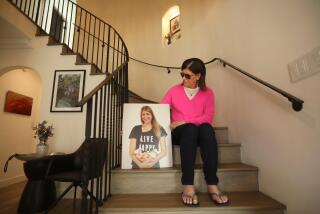Girl’s Prolonged Agony Makes a ‘Right to Die’ Pioneer of Her Mother : Medical ethics: A short life of suffering leads a state to change laws regarding children with hopeless conditions.
NEW HAVEN, Conn. — For most of the 14 years she lived, Stephanie Marshall never saw the sunlight, smelled the flowers or played in the park. She had no playmates. Her companions were pain and pills. Her brain rotted from a terminal, genetic illness known as Batten’s disease.
Still, she managed to inspire people. Her nurse learned to love her deeply. A family friend dedicated her life to helping the handicapped. A state agency revised its rules. A state representative sponsored legislation for terminally ill children.
Stephanie’s hipbones pulled from their sockets because of the degenerative disorder. Her stiffened legs were crossed like scissors. Seizures racked her body. Her 4-foot-5-inch frame was so fragile that her mother was unable to hold her only child without hurting her. Six years ago at Christmas, her weight dropped to 47 pounds.
Instead of a child’s laughter she let out bloodcurdling screams. She went blind and stopped talking when she was 4 1/2. Her diet was liquid, fed through a tube to her stomach along with 11 drugs to control seizures, pain and anxiety, as well as to clear her lungs so she wouldn’t drown in her own mucus and to settle her stomach.
Her nurse, Sandee McGee, was terrified that Stephanie was going to die while under her care, yet she prayed every day that Stephanie would die because the little girl suffered so much.
Catherine Marshall successfully pleaded for Stephanie’s right to die peacefully, without lifesaving measures, when her heart began to fail.
The mother’s lobbying got the Connecticut Department of Mental Retardation two years ago to revise its guidelines to allow the conditional withholding of resuscitation in cases such as Stephanie’s.
Catherine Marshall believed that Stephanie would live as long as she wanted. She had no desire either to hasten her death or to prolong her pain. She said she would not lift a hand to stop her dying when the time came, except to comfort her daughter.
That moment came at 12:15 p.m. on May 18, a Saturday. Her mother was with her, one hand caressing the back of Stephanie’s head, the other clutching her hand.
“She knew I was there,” said Marshall, breaking into sobs. “She knew I was there. I believe that she waited to die until she could see us.”
Rep. Lenny T. Winkler, assistant minority leader of the Connecticut House of Representatives, wrote Marshall that living-will legislation to be proposed in the 1992 session would allow parents to make decisions about the care of terminally ill children.
“I don’t believe any parent should be made to go through the frustration you must have experienced in your dealings with the state,” Winkler said.
Stephanie spent the last half of her life in a home for the handicapped in Norfolk, Conn. Sandee McGee was her nurse there between 1987 and 1989.
“Stephanie impacted everyone’s life at the nursery,” said McGee, who now lives in Melbourne, Fla. “She taught me how to love a lot deeper than I ever could before, because I just loved Stephanie to pieces. She taught me how to smell the flowers and enjoy the sunlight, because she never got to enjoy that.”
A family friend, Joanne Wilson, got her first job teaching handicapped and mentally retarded children because she knew the Marshalls. She had no experience.
Stephanie inspired her to earn a master’s degree in special education so she could teach severely disabled children, Wilson said. She since has moved to Tucson, Ariz., where she teaches and champions the disabled.
“It made me more of a humanist,” she said. “Knowing Stephanie changed how you felt about your own life. It changed how you felt about other people. It’s like she opened windows for me.
“Stephanie couldn’t talk, but yet you knew what made her happy. She let you know. It may have just been the relaxation of her body in a certain way. But she had ways of communicating and it made me know that everyone can communicate in some way, and that I could help teach that person to communicate more efficiently.”
Stephanie was born a normal child, “a little girl as bright as a new penny,” her mother said. As an infant, she had red hair that turned to light brown, then dark brown. Her two loves were flying and animals, and she imitated the sounds of both. She went flying with her father, a pilot, and fed the cows and horses on her grandmother’s farm.
At breakfast one morning in 1979, her eyes rolled off to one side and she suffered the first of her seizures. She was 2 1/2 years old.
From then on, her lot was a wrenching one. By her fourth birthday in March, 1981, she was going blind. She couldn’t coordinate well enough to ride her tricycle. She couldn’t stand up, and she wouldn’t stay down. She kept getting up and falling down.
The stress of Stephanie’s illness took a toll on her parents’ relationship. Jim and Catherine Marshall were divorced in November, 1986, but they never stopped working together for Stephanie. Three years after the divorce, in November, 1989, Jim Marshall was killed when his light plane crashed in bad weather.
Catherine Marshall, a 43-year-old senior administrative assistant at Yale University, was graduated from the University of New Haven with a master’s degree in public administration two weeks after Stephanie died. She had left teaching in 1981 because of Stephanie’s illness.
“For me, this was 14 years, because I started this program the year Stephanie was born and so it’s really strange that I should have completed it within such a short time of her death,” she said.
“It is my hope that, partly through my own life experiences and now that I do have my graduate degree, I will be able to meld these experiences and, hopefully, use them for the good of people and children who do have special needs. I’m not sure how that is going to happen, but I hope that it will happen.”
More to Read
Sign up for Essential California
The most important California stories and recommendations in your inbox every morning.
You may occasionally receive promotional content from the Los Angeles Times.










